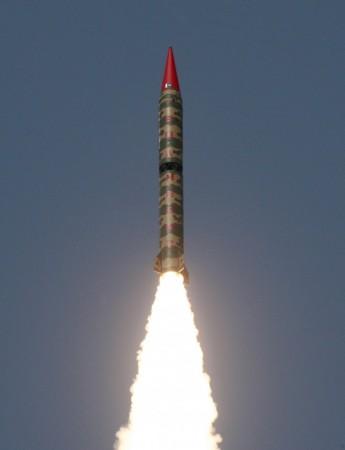
Just a few days after India successfully test fired Agni-V, a solid fueled Inter-continental Ballistic Missile (ICBM), Pakistan also test fired a nuclear capable ballistic missile, Hatf IV Shaheen-1A on Wednesday.
"Pakistan today successfully conducted the launch of the intermediate Range Ballistic Missile Hatf IV Shaheen-1A Weapon System. The missile is an improved version of Shaheen-1 with improvements in range and technical parameters. It is capable of carrying nuclear and conventional warheads," said Pakistan's Inter Services Public Relations (ISPR) in a press release.
"Today's launch, whose impact point was at sea, was witnessed by Director General Strategic Plans Division Lieutenant General Khalid Ahmed Kidwai (R), Chairman NESCOM Mr Muhammad Irfan Burney, Commander Army Strategic Force Command Lieutenant General Tariq Nadeem Gilani and other senior military officers, scientists and engineers," it added.
Pakistan had earlier informed India that it would conduct a long-range missile test in the Indian Ocean within five days. It also has asked Indian authorities to issue a notice to all commercial airlines to avoid the area where the test will be conducted.
The test firing of Pakistan's Shaheen-1A came just six days after India launched its first Inter-continental Ballistic Missile. Call it a coincidence but the timing of the test could make many raise the eyebrows as India and Pakistan have border dispute.
India test fired its indigenously built Agni-V with a range of more than 5,000 kilometers (3,100 miles) at Wheeler Island off Odisha coast from Integrated Test Range (ITR) on April 18.
With Agni-V, many claimed that India has joined elite nations that have Inter-continental Ballistic Missile capability. Till date, U.N. Security Council permanent members China, Russia, France, the United States and the United Kingdom have ICBM capability. Israel is also believed to have the capability.
The nuclear warhead-enabled Agni-V is 17 m long, 2 m wide and weighs 50 tonnes, and it can carry a pay-load of 1 tonne. It is an upgraded version of the indigenously built Agni series to be powered by solid rocket propellants. It is the fifth in the Agni series. India had earlier successfully test fired Agni-I (700-km), Agni-II (over 2,000-km), Agni-III (3,500 km- 5,000 km) and Agni-IV (of 2,500-3,500 km).
Sources said that DRDO has a series of plans on defence in the near future. The submarine-launched ballistic missile (SLBM) is expected to be operational by 1013 and a missile shield to combat drones by 2014. It is also working on quick-launch micro satellites and Star Wars-like laser weapons.










![BJP fields Tashi Gyalson for Ladakh; drops sitting MP [details]](https://data1.ibtimes.co.in/en/full/797185/bjp-fields-tashi-gyalson-ladakh-drops-sitting-mp-details.jpg?w=220&h=138)



